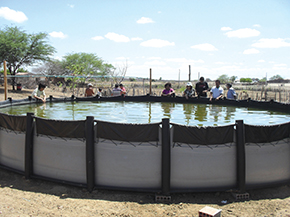
NILDO DA SILVA DIAS/UFERSAFish farming tank near city of MossoróNILDO DA SILVA DIAS/UFERSA
Exploiting saltwater’s potential for plant growing and fish farming in the area near Mossoró, a city in the state of Rio Grande do Norte, is the goal of a project coordinated by Professor Nildo da Silva Dias at the Environmental and Technological Sciences Department of the Federal Rural University of the Semiarid Region (Ufersa). Dias was awarded the 4th Fecomercio Sustainability Award in the Academy-Professor category, announced in late August 2014. “The project consists of integrated actions to sustainably use saline wastewater from rural communities and stimulate fish farming as a means of income,” says Dias, who is currently a postdoctoral researcher at the USDA Salinity Laboratory in California. In most rural communities in the Mossoró region, potable water is only available by drilling artesian wells. The problem is that water from these wells is brackish due to contact with crystalline bedrock. To make it fit to drink, the water undergoes a desalination process that generates what is known as saline wastewater, which is highly pollutant.
“Desalination produces 50% water and 50% saline wastewater, which ends up being released into the soil or rivers,” Dias explains. Initiatives implemented since 2009 have included using this wastewater to raise tilapia, a fish species that tolerates high salinity. Afterward, the effluent from the fish farms, which is rich in organic matter, is used to irrigate saplings of plant species from the Caatinga, as well as vegetables and forage plants.